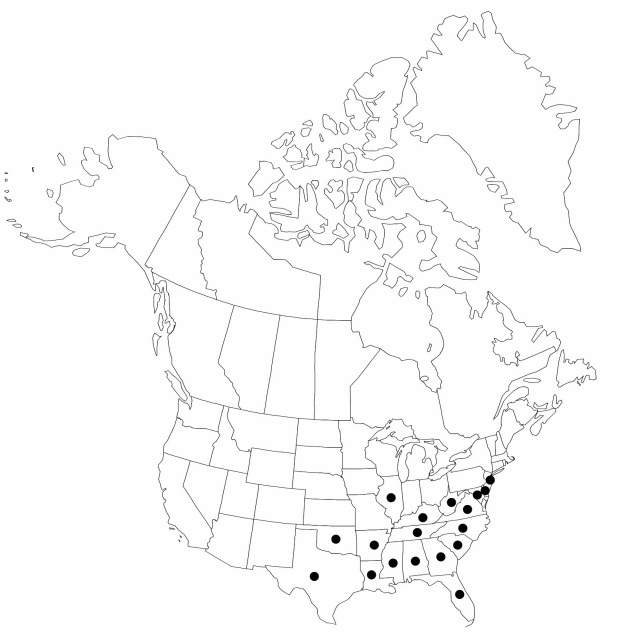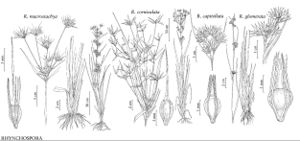Difference between revisions of "Rhynchospora glomerata"
Enum. Pl. 2: 234. 1805.
FNA>Volume Importer |
imported>Volume Importer |
||
| (6 intermediate revisions by 2 users not shown) | |||
| Line 7: | Line 7: | ||
|year=1805 | |year=1805 | ||
}} | }} | ||
| − | |basionyms={{Treatment/ID/ | + | |special_status={{Treatment/ID/Special_status |
| + | |code=F | ||
| + | |label=Illustrated | ||
| + | }}{{Treatment/ID/Special_status | ||
| + | |code=E | ||
| + | |label=Endemic | ||
| + | }} | ||
| + | |basionyms={{Treatment/ID/Basionym | ||
|name=Schoenus glomeratus | |name=Schoenus glomeratus | ||
|authority=Linnaeus | |authority=Linnaeus | ||
| + | |rank=species | ||
| + | |publication_title=Sp. Pl. | ||
| + | |publication_place=1: 44. 1753 | ||
}} | }} | ||
|synonyms={{Treatment/ID/Synonym | |synonyms={{Treatment/ID/Synonym | ||
|name=Phaeocephalum glomeratum | |name=Phaeocephalum glomeratum | ||
|authority=(Linnaeus) House | |authority=(Linnaeus) House | ||
| − | }}{{Treatment/ID/Synonym | + | |rank=species |
| + | }} {{Treatment/ID/Synonym | ||
|name=Rhynchospora cymosa | |name=Rhynchospora cymosa | ||
|authority=Muhlenberg ex Elliott | |authority=Muhlenberg ex Elliott | ||
| − | }}{{Treatment/ID/Synonym | + | |rank=species |
| + | }} {{Treatment/ID/Synonym | ||
|name=Rhynchospora glomerata var. angusta | |name=Rhynchospora glomerata var. angusta | ||
|authority=Gale | |authority=Gale | ||
| − | }}{{Treatment/ID/Synonym | + | |rank=variety |
| + | }} {{Treatment/ID/Synonym | ||
|name=Rhynchospora glomerata var. paniculata | |name=Rhynchospora glomerata var. paniculata | ||
|authority=(A. Gray) Chapman | |authority=(A. Gray) Chapman | ||
| − | }}{{Treatment/ID/Synonym | + | |rank=variety |
| + | }} {{Treatment/ID/Synonym | ||
|name=Rhynchospora glomerata var. robustior | |name=Rhynchospora glomerata var. robustior | ||
|authority=Kunth | |authority=Kunth | ||
| − | }}{{Treatment/ID/Synonym | + | |rank=variety |
| + | }} {{Treatment/ID/Synonym | ||
|name=Rhynchospora paniculata | |name=Rhynchospora paniculata | ||
| − | |authority= | + | |authority= |
| − | }}{{Treatment/ID/Synonym | + | |rank=species |
| + | }} {{Treatment/ID/Synonym | ||
|name=Triodon glomeratus | |name=Triodon glomeratus | ||
| − | |authority= | + | |authority= |
| + | |rank=species | ||
}} | }} | ||
|hierarchy=Cyperaceae;Rhynchospora;Rhynchospora glomerata | |hierarchy=Cyperaceae;Rhynchospora;Rhynchospora glomerata | ||
| Line 46: | Line 63: | ||
|habitat=Moist to wet meadows, swales, fens, flatwoods, and bogs, 0–500 m | |habitat=Moist to wet meadows, swales, fens, flatwoods, and bogs, 0–500 m | ||
|distribution=Ala.;Ark.;Del.;Fla.;Ga.;Ill.;Ky.;La.;Md.;Miss.;N.J.;N.C.;Okla.;S.C.;Tenn.;Tex.;Va.;W.Va. | |distribution=Ala.;Ark.;Del.;Fla.;Ga.;Ill.;Ky.;La.;Md.;Miss.;N.J.;N.C.;Okla.;S.C.;Tenn.;Tex.;Va.;W.Va. | ||
| − | |discussion=<p>Rhynchospora glomerata is often associated with R. capitellata and is distinguishable by its taller, slightly stouter habit; longer, slightly paler spikelets; and longer and broader fruit body. It is a common lowland weed in the southern Piedmont, Atlantic coastal plain, and Gulf coastal plain, where it is often more associated with R. inexpansa.</p> | + | |discussion=<p><i>Rhynchospora glomerata</i> is often associated with <i>R. capitellata</i> and is distinguishable by its taller, slightly stouter habit; longer, slightly paler spikelets; and longer and broader fruit body. It is a common lowland weed in the southern Piedmont, Atlantic coastal plain, and Gulf coastal plain, where it is often more associated with <i>R. inexpansa</i>.</p> |
|tables= | |tables= | ||
|references= | |references= | ||
| Line 55: | Line 72: | ||
-->{{#Taxon: | -->{{#Taxon: | ||
name=Rhynchospora glomerata | name=Rhynchospora glomerata | ||
| − | |||
|authority=(Linnaeus) Vahl | |authority=(Linnaeus) Vahl | ||
|rank=species | |rank=species | ||
| Line 68: | Line 84: | ||
|publication title=Enum. Pl. | |publication title=Enum. Pl. | ||
|publication year=1805 | |publication year=1805 | ||
| − | |special status= | + | |special status=Illustrated;Endemic |
| − | |source xml=https:// | + | |source xml=https://bitbucket.org/aafc-mbb/fna-data-curation/src/2e0870ddd59836b60bcf96646a41e87ea5a5943a/coarse_grained_fna_xml/V23/V23_362.xml |
|genus=Rhynchospora | |genus=Rhynchospora | ||
|species=Rhynchospora glomerata | |species=Rhynchospora glomerata | ||
Latest revision as of 20:40, 5 November 2020
Plants perennial, cespitose, 80–150 cm; rhizomes absent. Culms excurvednodding, leafy, triangular, slender; principal leaves overtopped by culm; blades flat, 2.5–5 mm wide, apex attenuate, trigonous. Inflorescences terminal and axillary, spikelet clusters mostly 2–6, compact, turbinate to hemispheric, 1.5–2 cm wide; peduncles progressively shorter distally on culm; bracteal leaves mostly exceeding subtended groups. Spikelets crowded, deep redbrown, lanceellipsoid, 4.5–6.5 mm; fertile scales ovatelanceolate, 3.5–4(–4.5) mm, apex acute, midrib mostly shortexcurrent. Flowers: perianth bristles 6, overtopping tubercle, antrorsely barbellate. Fruits (1–)2(–3) per spikelet, 3–4 mm; body dark redbrown with pale center, stipitate, lenticular, obovoid, or orbicular, 1.5–2 × 1.2–1.4 mm, base narrowed, margins pale, wirelike; surfaces slick; tubercle triangular-subulate, 1.3–1.5(–1.8) mm.
Phenology: Fruiting summer–fall.
Habitat: Moist to wet meadows, swales, fens, flatwoods, and bogs, 0–500 m
Distribution

Ala., Ark., Del., Fla., Ga., Ill., Ky., La., Md., Miss., N.J., N.C., Okla., S.C., Tenn., Tex., Va., W.Va.
Discussion
Rhynchospora glomerata is often associated with R. capitellata and is distinguishable by its taller, slightly stouter habit; longer, slightly paler spikelets; and longer and broader fruit body. It is a common lowland weed in the southern Piedmont, Atlantic coastal plain, and Gulf coastal plain, where it is often more associated with R. inexpansa.
Selected References
None.
